

 Published in 2011 by Stewart, Tabori & Chang
Published in 2011 by Stewart, Tabori & Chang
An imprint of ABRAMS Copyright 2011 by Sanjeev Kapoor All rights reserved. No portion of this book may be reproduced, stored in a retrieval system, or transmitted in any form or by any means, mechanical, electronic, photocopying, recording, or otherwise, without written permission from the publisher. Library of Congress Cataloging-in-Publication Data Kapoor, Sanjeev, 1964
How to cook Indian : more than 500 classic recipes for the modern kitchen
/Sanjeev Kapoor.
p. cm.
Includes index.
ISBN 978-1-58479-913-9 (alk. paper)
1. 2. Cookbooks. I. I.
Title.
TX724.5.I4K2964 2011
641.5954dc22
2010050496 EDITOR: Natalie Kaire
DESIGNERS: Galen Smith and Danielle Young
PRODUCTION MANAGER: Anet Sirna-Bruder The text of this book was composed in Filosofia and Bureau Grotesque. Stewart, Tabori & Chang books are available at special discounts when purchased in quantity for premiums and promotions as well as fundraising or educational use. Special editions can also be created to specification. For details, contact specialsales@abramsbooks.com or the address below. 
www.abramsbooks.com
CONTENTS

I WAS BORN IN A SMALL TOWN CALLED AMBALA, which is in the state of Haryana, in North India. I spent most of my childhood in Delhi, but my fathers job took him from city to city, so we moved a lot.
My mother has family in Meerut, in Uttar Pradesh, and my paternal aunt lives in Kolkata, and I traveled around India visiting them when I was young. Wherever my parents set up house, my mother exchanged food and recipes with neighbors from other states and regions, and those dishes made their way onto our table. Eventually I married Alyona, who is a Kutchi from the western Indian state of Gujarat. Her sister is a chef and her mother is a very inspirational cook. These accomplished women have greatly influenced my own way of cooking. As an adult, I traveled to all the major cities in the south and the northeast of India.
I have vacationed on the beautiful beaches that line Indias extensive coasts and enjoyed the fresh catch from the sea. I have driven the coconut-lined roads of the Konkan coast and feasted on the robust food found there. All my travels, all my experiences, and all my research into the history and origins of Indian cuisine have been instrumental in making me the chef that I am. And so this book is filled with pieces of my heart: some personal stories, a bit of history, and, of course, hundreds of new and classic recipes, many of them modern and simplified adaptations of dishes that have been enjoyed in India for centuries. India has long been a favorite destination for travelers, in part because of its astonishingly varied culture, geography, and rich history. It is a country of contrasts and extremes.
India has the worlds most recently formed (and still rising) mountainsthe Himalayasas well as the worlds most ancient rocks. The country also has the worlds wettest placeat Chirapunjiand the hottest desertat Thar. There are stretches of permanent snow in the Himalayas and Karakoram, and tropical rain forests in Kerala. If geography has any impact on the development of a peoples food, India has surely benefitted from this, as it has come up with one of the richest and most diverse cuisines in the world. You could taste a new dish every day, and it would take more than a few lifetimes before you would exhaust the entire repertoire of Indian food. When traveling south from the northernmost states or from east to west, you will encounter a distinct diversity of tastes and spices.
While wheat is a staple in the northern, western, and central states, rice predominates in the south and east. While heady aromas of saffron and anise welcome you to Kashmir, a whiff of curry leaves being tempered in oil makes you feel at home in Tamil Nadu. If a diverse presentation of pulses interests you in Rajasthan, the magnificent variety of fish in the Bengal will enthrall you. But while regional cuisines vary tremendously, they share some common threads. Indian food is healthy, featuring grains, pulses, and loads of vegetables at every meal; the dishes highlight hot, tart, sweet, and tangy flavors in exquisite balance; and they are much easier to cook than you might expect. In this book, I try to put to rest the myth that Indian food has to be elaborately prepared.
Many of the ingredient lists are long, its true, but once you have the basic spices on hand, its just a matter of tossing them into your pan. And while some of the recipes are composed of many separate steps, each one is simple and straightforward. Use the best-quality ingredients you can find, as good ingredients are essential to good cooking. Measure, chop, and set out the ingredients before you start heating your pan. Taste each dish before serving and adjust the seasoning if necessary. Indian food is very popular because of its wide variety of vegetarian dishes.
The world is turning toward vegetarianism, and I can say emphatically that the best guide to vegetarian cooking is Indian cuisine, with its vast array of vegetable-based main courses and the lentil stews called dals, the many yogurt and vegetable medleys called raitas, and the hot and sweet pickles that accompany them. That said, fish (both from the rivers and the sea), chicken, goat, and lamb are abundant, and as youll see in these pages, there are many dishes that use them to their best advantage. Whether youve been cooking Indian food for years or youre just beginning, these recipessome of them titled in Hindi, some in Hindi-English, some in regional languages to honor the spirit of where the dishes originatedwill take you on an amazing journey. This book is very important to me, and through it I hope to share my passion for Indian food and life with you. The only things missing here are the sound of spices crackling in oil and the singular aroma that rises from the pan as they sputter and sizzle. But that is something you can provide.
Happy cooking! SANJEEV KAPOOR  COMMONLY USED INGREDIENTS TO HAVE ON HAND If you keep these staple ingredients in your cupboard and refrigerator, a delicious Indian meal is a simple matter of picking up a couple fresh vegetables or some meat and diving right into any of the recipes in this book. Dals: If you have one or two types of dal (lentils) in your pantry, youre never more than a few steps from a hearty and satisfying meal. Keep them in glass jars or airtight plastic containers to keep them fresh. See the glossary (page 587) for descriptions of the varieties of dal used in this book. Garlic and red onions: Keep plenty of alliums handy in a cool, dry pantry or in a basket on the countertop, as theyre used in most of the savory dishes in this book. Ghee: Keep a jar of ghee in the pantry or in the refrigerator; it should keep for several months either way.
COMMONLY USED INGREDIENTS TO HAVE ON HAND If you keep these staple ingredients in your cupboard and refrigerator, a delicious Indian meal is a simple matter of picking up a couple fresh vegetables or some meat and diving right into any of the recipes in this book. Dals: If you have one or two types of dal (lentils) in your pantry, youre never more than a few steps from a hearty and satisfying meal. Keep them in glass jars or airtight plastic containers to keep them fresh. See the glossary (page 587) for descriptions of the varieties of dal used in this book. Garlic and red onions: Keep plenty of alliums handy in a cool, dry pantry or in a basket on the countertop, as theyre used in most of the savory dishes in this book. Ghee: Keep a jar of ghee in the pantry or in the refrigerator; it should keep for several months either way.
Next page
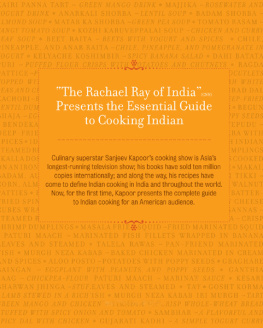

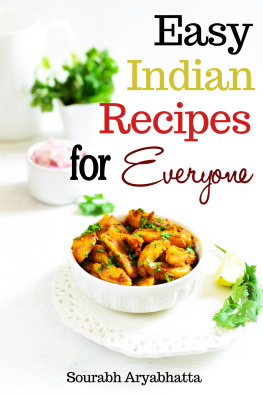
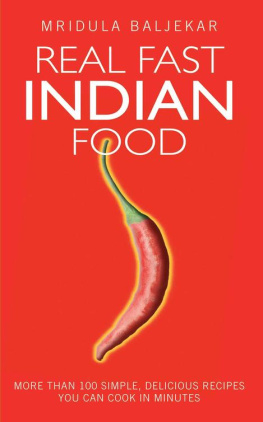
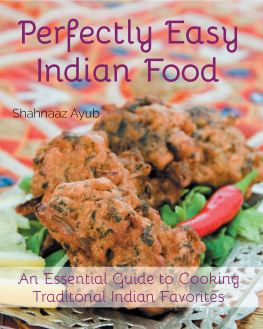
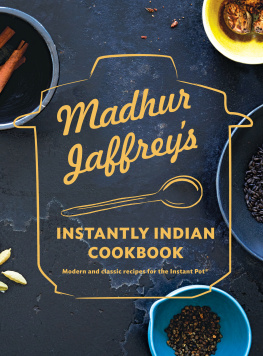
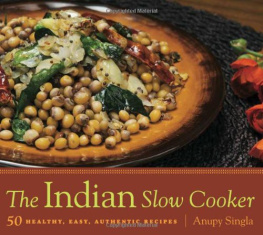


 Published in 2011 by Stewart, Tabori & Chang
Published in 2011 by Stewart, Tabori & Chang
 I WAS BORN IN A SMALL TOWN CALLED AMBALA, which is in the state of Haryana, in North India. I spent most of my childhood in Delhi, but my fathers job took him from city to city, so we moved a lot.
I WAS BORN IN A SMALL TOWN CALLED AMBALA, which is in the state of Haryana, in North India. I spent most of my childhood in Delhi, but my fathers job took him from city to city, so we moved a lot.  COMMONLY USED INGREDIENTS TO HAVE ON HAND If you keep these staple ingredients in your cupboard and refrigerator, a delicious Indian meal is a simple matter of picking up a couple fresh vegetables or some meat and diving right into any of the recipes in this book. Dals: If you have one or two types of dal (lentils) in your pantry, youre never more than a few steps from a hearty and satisfying meal. Keep them in glass jars or airtight plastic containers to keep them fresh. See the glossary (page 587) for descriptions of the varieties of dal used in this book. Garlic and red onions: Keep plenty of alliums handy in a cool, dry pantry or in a basket on the countertop, as theyre used in most of the savory dishes in this book. Ghee: Keep a jar of ghee in the pantry or in the refrigerator; it should keep for several months either way.
COMMONLY USED INGREDIENTS TO HAVE ON HAND If you keep these staple ingredients in your cupboard and refrigerator, a delicious Indian meal is a simple matter of picking up a couple fresh vegetables or some meat and diving right into any of the recipes in this book. Dals: If you have one or two types of dal (lentils) in your pantry, youre never more than a few steps from a hearty and satisfying meal. Keep them in glass jars or airtight plastic containers to keep them fresh. See the glossary (page 587) for descriptions of the varieties of dal used in this book. Garlic and red onions: Keep plenty of alliums handy in a cool, dry pantry or in a basket on the countertop, as theyre used in most of the savory dishes in this book. Ghee: Keep a jar of ghee in the pantry or in the refrigerator; it should keep for several months either way.